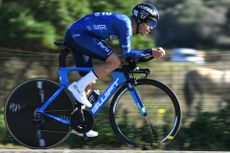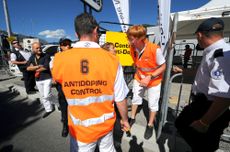Doping

An unfortunate truth for cycling fans everywhere is that doping has had no small part to play in the history of the sport.
The use of performance enhancing substances were widely accepted in the early era of gruelling races like the Tour de France. A number of incidents however, including the death of Danish rider Knud Enemark Jensen at the 1960 Olympic Games team time trial, who was using amphetamines at the time, saw rules gradually introduced to combat doping.
Still, even to the present day, positive tests are not uncommon.
Lance Armstrong, who had won seven consecutive Tour de France titles until he was found guilty of using PEDs in a 2012 report, is potentially the most notorious drug cheat in cycling, if not sporting history.
But while cycling's uneasy relationship with doping continues, scientific gains have been made amongst the agencies trying to catch those who cheat, with the introduction of the Athlete Biological Passport (ABP) at the beginning of the 2008 race season by the UCI.
The World Anti-Doping Agency (WADA) is the ruling authority on anti-doping for more than 600 sports organisations around the world, including cycling's international body, the UCI.
-

Spanish rider leaves Red Bull-Bora-Hansgrohe after being provisionally suspended over 'unexplained abnormalities' in biological passport
Oier Lazkano sanctioned by UCI over abnormalities 2022-2024
By Adam Becket Published
-

World Anti-Doping Agency to ban carbon monoxide inhalation for performance enhancement
The use of the carbon monoxide rebreather tool used for 'diagnostic purposes' will remain legal
By Meg Elliot Published
-

'Utterly irresponsible and immoral' - Olympic committee warns pro-doping Enhanced Games could lead to deaths
New event slammed as a "betrayal" of sporting integrity
By Tom Davidson Published
-

French cyclist given 10-month suspended prison sentence for doping
Marion Sicot said doping formed "an integral part" of cycling
By Tom Davidson Published
-

French cyclist faces suspended prison sentence and €5,000 fine in doping trial
Marion Sicot, who admitted to taking EPO in 2019, is currently on trial in France
By Tom Davidson Published
-

Irish Continental level professional cyclist suspended after EPO positive
Jesse Ewart, who rode for Terengganu Cycling, has been banned until 2027
By Adam Becket Published
-

Steroids found in pro cyclist’s anti-doping test sample
Antwan Tolhoek has been provisionally suspended by the UCI while proceedings are ongoing
By Tom Davidson Last updated
-

Jonas Vingegaard reveals he missed an anti-doping test
'It's not great to have a missed test hanging over you,' says Tour de France champion
By Tom Davidson Published
-

Jumbo-Visma rider Michel Hessmann suspended after positive anti-doping test
The 22-year-old's out-of-competition sample detected the presence of diuretics
By Tom Davidson Published
-

Former British Cycling doctor Richard Freeman given four-year doping ban
Freeman chose not to defend himself before the anti-doping panel
By Tom Davidson Published
-

'We are not cheaters' says Belgian rider Shari Bossuyt after anti-doping positive
The Canyon-SRAM rider tested positive for Letrozole in an anti-doping control in March
By Tom Davidson Published
-

Convicted EPO doper Jarlinson Pantano returns to cycling with Colombian EPM team
Former Trek-Segafredo and IAM Cycling rider rejoins peloton after his four-year band expires
By Adam Becket Published
-

"Failing that drug test was the best thing that had ever happened to me"
Abuse victim and disgraced cycling champion Geneviève Jeanson finds solace in return to bike racing
By Anne-Marije Rook Published
-

29 cases of alleged doping recorded in cycling in 2022, but only one at WorldTour
Most came from semi-professional ranks, MPCC finds
By Tom Davidson Published
-

Spanish police crack down on doping ring, former Kelme coach questioned
Miguel Ángel López denies any involvement in statement
By Adam Becket Last updated
-

American cyclist Jackson ’Huntley’ Nash handed lifetime ban after doping violations
USADA hand down penalty after multiple offences discovered by investigation
By Adam Becket Published
-

UCI suspends continental team's licence due to doping investigation
W52-FC Porto cannot compete in any races after an investigation conducted by the Anti-Doping Authority of Portugal
By Ryan Dabbs Last updated
-

Guillaume Martin: The big question is this grey area of ketones
The Frenchman says he is in favour of banning ketones for reasons of fairness
By Jonny Long Published
-

Trial begins into French doctor and two others accused of attempting to dope cyclists
Bernand Sainz has been involved in cycling circles for the best part of six decades
By Chris Marshall-Bell Published
-

Julian Alaphilippe doesn't share Arnaud Démare's concerns over performance products used in the peloton
The Frenchman also says he 'won't be shouting from the rooftops' when he eventually decides to compete for the Tour de France yellow jersey
By Jonny Long Published
-

Johan Bruyneel: 'Lance Armstrong was the perfect target to be sacrificed' to clean up cycling
The former rider and team boss says in his era the choice was 'either you adapt and you dope yourself, or you disappear'
By Jonny Long Published
-

British Paralympic hopeful cyclist banned for three years for doping offence
Erin McBride, who joined the British Cycling team after switching from athletics this year, tested positive for a banned substance
By Alex Ballinger Published
-

Two Italian cyclists banned following doping violations
One was an amateur time trial champion
By Jonny Long Published
-

US amateur rider handed four-year doping ban after winning cat three race
The 49-year-old was tested after his win in the Arizona State Championships this summer
By Alex Ballinger Published
-

German former rider receives nine year doping ban and stripped of 11 years worth of results
Björn Thurau retired from racing at the end of 2019
By Tim Bonville-Ginn Published
-

David Lappartient: Riders are sharing rumours of new doping techniques, they feel there is a gap
"Man is limitless in the imagination to cheat," the UCI President said
By Jonny Long Published
-

UK Anti-Doping's case against Richard Freeman paused after doping doctor appeals tribunal verdict
UKAD will resume proceedings against Richard Freeman after his High Court appeal
By Jonny Long Published
-

Doping ban for former Trek-Segafredo rider upheld after his appeal fails
The Court of Arbitration for Sport upheld the four-year ban for the 36-year-old
By Alex Ballinger Last updated
-

Georg Preidler says he became involved in blood doping ‘out of pure curiosity’
Georg Preidler has told a court he became involved in blood doping “out of pure curiosity.”
By Alex Ballinger Published
